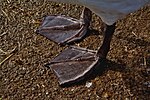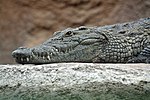Aquatic locomotion or swimming is biologically propelled motion through a liquid medium. The simplest propulsive systems are composed of cilia and flagella...
49 KB (6,586 words) - 14:46, 1 November 2024
Locomotion may refer to: Motion (physics) Robot locomotion, of man-made devices Aquatic locomotion Flight Locomotion in space Terrestrial locomotion Animal...
2 KB (246 words) - 01:29, 6 June 2024
Fish locomotion is the various types of animal locomotion used by fish, principally by swimming. This is achieved in different groups of fish by a variety...
49 KB (5,929 words) - 14:57, 3 May 2024
of aquaria and oceanaria. Wetlands portal Aquatic Aquatic ecosystem Aquatic locomotion Aquatic mammal Aquatic plant Freshwater snail Marine biology Marine...
22 KB (2,282 words) - 14:30, 23 October 2024
of salamander locomotion. Animal locomotion Aquatic locomotion Locomotion in space Locomotive Robot locomotion Terrestrial locomotion Guo, Z. V.; Mahadeven...
25 KB (3,291 words) - 20:08, 16 October 2024
efficient locomotion, which is in most cases essential for basic functions such as catching prey. A fusiform, torpedo-like body form is seen in many aquatic animals...
78 KB (8,863 words) - 06:31, 9 October 2024
Webbed foot (section Terrestrial locomotion)
specialized limb with interdigital membranes (webbings) that aids in aquatic locomotion, present in a variety of tetrapod vertebrates. This adaptation is...
27 KB (3,158 words) - 19:37, 21 February 2024
Snake (redirect from Snake locomotion)
Lateral undulation is the sole mode of aquatic locomotion, and the most common mode of terrestrial locomotion. In this mode, the body of the snake alternately...
152 KB (15,151 words) - 14:20, 2 November 2024
Terrestrial locomotion has evolved as animals adapted from aquatic to terrestrial environments. Locomotion on land raises different problems than that...
32 KB (4,156 words) - 02:38, 15 October 2024
Several organisms are capable of rolling locomotion. However, true wheels and propellers—despite their utility in human vehicles—do not play a significant...
61 KB (5,832 words) - 19:08, 22 September 2024
Fin and flipper locomotion occurs mostly in aquatic locomotion, and rarely in terrestrial locomotion. From the three common states of matter — gas, liquid...
10 KB (1,436 words) - 02:01, 4 March 2022
alien plants. Wetlands portal Aquatic animal Aquatic Botany (journal) Aquatic Aquatic ecosystem Aquatic locomotion Aquatic mammal Botany List of freshwater...
39 KB (4,181 words) - 07:11, 4 November 2024
generally similar to Pakicetus, but smaller and more gracile. Therefore, locomotion is also thought to be reliant on quadrupedal paddling. Ichthyolestes exhibits...
16 KB (1,723 words) - 19:40, 5 July 2024
Flipper (anatomy) (section Locomotion)
broad, flattened limb adapted for aquatic locomotion. It refers to the fully webbed, swimming appendages of aquatic vertebrates that are not fish. In...
15 KB (1,656 words) - 16:16, 10 September 2024
ultimately decline and perish. Wetlands portal Aquatic animal Aquatic ecosystem Aquatic locomotion Aquatic mammal Aquatic plant Botany Plant community Raunkiær...
3 KB (316 words) - 15:18, 13 October 2024
fishes that it actually evolved a dorsal fin and tail fin for improved aquatic locomotion. These structures are all the more remarkable because they evolved...
89 KB (7,654 words) - 01:57, 4 November 2024
Bio-inspired robotics (category Robot locomotion)
Bio-inspired robotic locomotion is a subcategory of bio-inspired design. It is about learning concepts from nature and applying them to the design of real-world...
26 KB (3,189 words) - 17:50, 22 October 2024
Pakicetus (section Possible semi-aquatic nature)
Hussain, S. T.; Arif, M. (1994). "Fossil Evidence for the Origin of Aquatic Locomotion in Archaeocete Whales". Science. 263 (5144): 210–212. Bibcode:1994Sci...
17 KB (1,761 words) - 21:29, 24 October 2024
are used in a variety of ways. They provide a source of thrust for aquatic locomotion for fish, cetaceans and crocodilians and other forms of marine life...
13 KB (1,394 words) - 14:01, 5 October 2024
Tetrapod (section Locomotion)
The transition from a body plan for gill-based aquatic respiration and tail-propelled aquatic locomotion to one that enables the animal to survive out...
104 KB (10,592 words) - 10:59, 26 October 2024
interacting surfaces by electrostatic interactions and covalent bonding. Aquatic locomotion Bacterial motility Cytoskeleton Spirostomum Squirmer Vorticella Hinchliff...
93 KB (9,333 words) - 00:16, 19 May 2024
was inspired by those of Neon Genesis Evangelion and invertebrate aquatic locomotion among sea creatures such as jellyfish, octopuses, and squid, to imagine...
145 KB (11,918 words) - 23:47, 30 October 2024
on fish as a means of locomotion. Fish fins are used to generate thrust and control the subsequent motion. Fish and other aquatic animals, such as cetaceans...
59 KB (4,733 words) - 23:47, 26 August 2024
bodies of water too. Wetlands portal Aquatic animal Aquatic ecosystem Aquatic locomotion Aquatic mammal Aquatic plant Marine invertebrates Marine mammal...
18 KB (2,234 words) - 13:48, 27 October 2024
Tail sailing (category Aquatic locomotion)
Tail sailing refers to the action of whales lifting their tails clear of the water for long periods of time. The process is rarely observed by humans,...
2 KB (171 words) - 08:22, 6 September 2024
Crocodile (section Locomotion)
functional equivalent of a diaphragm by incorporating muscles used for aquatic locomotion into respiration. Salt glands are present in the tongues of crocodiles...
106 KB (9,707 words) - 16:57, 29 October 2024
Jet propulsion (category Aquatic locomotion)
gills prior to exhalation, fulfilling the dual purpose of respiration and locomotion. Sea hares (gastropod molluscs) employ a similar method, but without the...
13 KB (1,509 words) - 14:39, 9 October 2024
Spinosaurus (section Locomotion and posture)
Lauder, George V.; Pierce, Stephanie E. (May 7, 2020). "Tail-propelled aquatic locomotion in a theropod dinosaur". Nature. 581 (7806): 67–70. Bibcode:2020Natur...
102 KB (11,394 words) - 06:53, 2 November 2024
medial, unpaired fin that is located on the midline of the backs of some aquatic vertebrates. In development of the embryo in teleost fish, the dorsal fin...
7 KB (819 words) - 23:18, 20 May 2024
Fish (category Aquatic ecology)
M.; Davies, J. B. C. (1999). "Review of Fish Swimming Modes for Aquatic Locomotion" (PDF). IEEE Journal of Oceanic Engineering. 24 (2): 237–252. Bibcode:1999IJOE...
102 KB (10,242 words) - 17:16, 30 October 2024




























